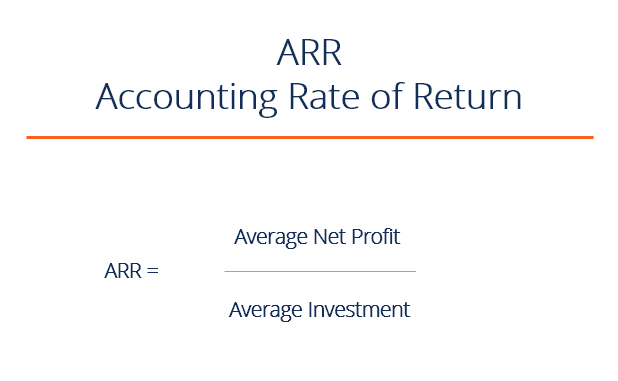Accounting Rate of Return
Rate of return from an accounting perspective
What is Accounting Rate of Return?
Accounting Rate of Return is the average net income an asset is expected to generate divided by its average capital cost, expressed as an annual percentage. It is a formula used to make capital budgeting decisions.
The accounting rate of return is used in situations where companies are deciding on whether or not to invest in an asset (a project, an acquisition, etc.) based on the future net earnings expected compared to the capital cost.
Accounting Rate of Return Formula
The formula for calculating the accounting rate of return is:
Accounting Rate of Return = Average Annual Profit / Average Investment
Where:
- Average Annual Profit = Total profit over Investment Period / Number of Years
- Average Investment = (Book Value at Year 1 + Book Value at End of Useful Life) / 2

- To learn more, launch our financial analysis courses!
Components of Accounting Rate of Return
If the accounting rate of return is equal to 5%, this means that the project is expected to earn five cents for every dollar invested per year.
In terms of decision making, if the accounting rate of return is equal to or greater than a company’s required rate of return, the project is acceptable because the company will earn at least the required rate of return.
If the accounting rate of return is less than the required rate of return, the project should be rejected. Therefore, the higher the accounting rate of return, the more profitable the company will become.
Read more about hurdle rates.
Example 1
XYZ Company is looking to invest in some new machinery to replace its current malfunctioning one. The new machine, which costs $420,000, would increase annual revenue by $200,000 and annual expenses by $50,000. The machine is estimated to have a useful life of 12 years and zero salvage value.
| Step 1: Calculate Average Annual Profit | ||
| Inflows, Years 1-12 | ||
| (200,000*12) | $2,400,000 | |
| Less: Annual Expenses | ||
| (50,000*12) | -$600,000 | |
| Less: Depreciation | -$420,000 | |
| Total Profit | $1,380,000 | |
| Average Annual Profit | ||
| (1,380,000/12) | $115,000 | |
| Step 2: Calculate Average Investment | ||
| Average Investment | ||
| ($420,000 + $0)/2 = $210,000 | ||
| Step 3: Use the Formula | ||
| Accounting Rate of Return = $115,000/$210,000 = 54.76% | ||
Therefore, this means that for every dollar invested, the investment will return a profit of about 54.76 cents.
Example 2
XYZ Company is considering investing in a project that requires an initial investment of $100,000 for some machinery. There will be net inflows of $20,000 for the first two years, $10,000 in years three and four, and $30,000 in year five. Finally, the machine has a salvage value of $25,000.
| Step 1: Calculate Average Annual Profit | ||
| Inflows, Years 1 & 2 | ||
| (20,000*2) | $40,000 | |
| Inflows, Years 3 & 4 | ||
| (10,000*2) | $20,000 | |
| Inflow, Year 5 | $30,000 | |
| Less: Depreciation | ||
| (100,000-25,000) | -$75,000 | |
| Total Profit | $15,000 | |
| Average Annual Profit | ||
| (15,000/5) | $3,000 | |
| Step 2: Calculate Average Investment | ||
| Average Investment | ||
| ($100,000 + $25,000) / 2 = $62,500 | ||
| Step 3: Use the Formula | ||
| Accounting Rate of Return = $3,000/$62,500 = 4.8% | ||
Download the Free Accounting Rate of Return Template
Enter your name and email in the form below and download the free template now!
* By submitting your email address, you consent to receive email messages (including discounts and newsletters) regarding Corporate Finance Institute and its products and services and other matters (including the products and services of Corporate Finance Institute's affiliates and other organizations). You may withdraw your consent at any time.
This request for consent is made by Corporate Finance Institute, #1392 - 1771 Robson Street, Vancouver, BC V6G 3B7, Canada. www.corporatefinanceinstitute.com. [email protected]. Please click here to view CFI`s privacy policy.
Limitations to Accounting Rate of Return
Although the accounting rate of return is an effective tool to grasp a general idea of whether to proceed with a project in terms of its profitability, there are several limitations to this approach:
- It ignores the time value of money. It assumes accounting income in future years has the same value as accounting income in the current year. A better metric that considers the present value of all future cash flows is NPV and Internal Rate of Return (IRR).
- It does not consider the increased risk of long-term projects and the increased variability associated with prolonged projects.
- It is only a financial guide for projects. Sometimes projects are proposed and implemented to enhance other important variables such as safety, environmental concerns, or governmental regulations.
- It is not an ideal comparative metric between projects because different projects have different variables, such as time and other non-financial factors to consider.
To learn more, launch our financial analysis courses!
Additional Resources
We hope the above article has been a helpful guide to understanding the Accounting Rate of Return, the formula, and how you can use it in your career. To keep learning and advancing your career, the additional CFI resources below will be helpful: